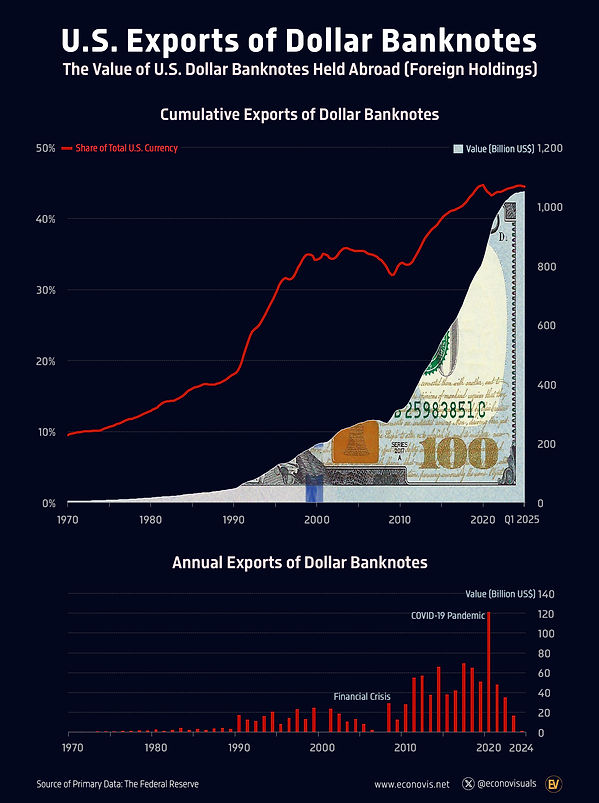U.S. Dollar Banknotes Abroad (1970–2025)
The Growing Value of U.S. Currency Held Outside the United States
Econovis Team
For more than half a century, the U.S. dollar has functioned not only as America’s legal tender but also as the world’s reserve currency. While most exports are measured in barrels of oil, tons of machinery, or shipments of airplanes, one of America’s most valuable exports is something far simpler: its banknotes. A small green piece of paper, most famously the $100 bill featuring Benjamin Franklin, has become a store of value and a medium of exchange across much of the globe.
By the first quarter of 2025, the value of U.S. dollar banknotes circulating outside the United States reached $1.05 trillion, accounting for 45% of all U.S. currency in circulation. In other words, nearly half of America’s paper money supply is held abroad. This reflects the unparalleled role of the dollar as a global safe asset, relied upon in regions where local currencies are unstable or where access to international markets requires a trusted medium of exchange.

The historical growth of foreign-held U.S. banknotes is striking. In 1970, overseas holdings amounted to just $5.4 billion. Over the next five decades, that number increased at a compound annual growth rate (CAGR) of 10.1%, outpacing the 7.2% growth rate of total U.S. currency in circulation. Today, the sheer scale of dollar holdings abroad underscores its centrality to global trade, finance, and personal savings.
The largest expansion occurred during the period from 2008 to 2021, when demand for physical U.S. banknotes rose by an extraordinary $700 billion. The 2008 global financial crisis, followed by years of uncertainty in both advanced and emerging economies, reinforced the dollar’s role as a safe haven. This surge culminated in 2020, during the onset of the COVID-19 pandemic, when foreign-held U.S. banknotes jumped by $121 billion in a single year—a 15% increase, the largest on record. The unprecedented shock of the pandemic drove households, businesses, and governments worldwide to seek liquidity and safety, with the U.S. dollar at the center.
Since 2022, however, the growth of overseas dollar holdings has plateaued. Despite global inflation and geopolitical tensions, the stock of U.S. banknotes abroad has shown little change through 2025. Several factors explain this shift. First, the explosive growth of digital payment systems—both in the United States and abroad—has reduced reliance on physical cash. Second, the rise of cryptocurrencies and stablecoins has provided an alternative (though still small in scale) for cross-border transactions and digital savings. Third, after years of rapid accumulation, many regions may have simply reached a saturation point in demand for physical dollars.
The long-term implications remain uncertain. On one hand, the dollar’s global role as a trusted currency is unlikely to diminish soon, especially given the lack of credible alternatives. On the other hand, the stagnation in foreign banknote demand may signal a turning point: while the U.S. dollar remains unrivaled in global finance, its most visible export—the paper bill—could be entering a period of slower growth as the world moves further into the digital age.
